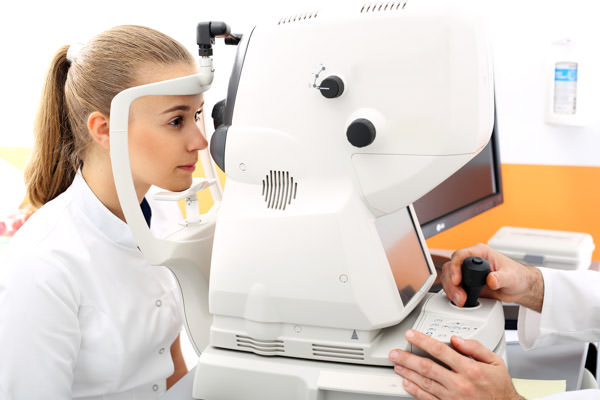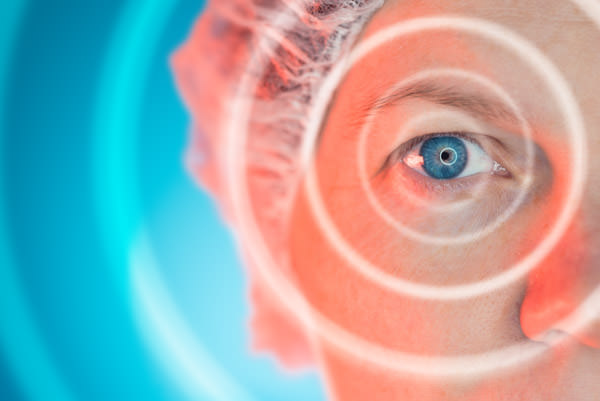Optical Coherence Tomography (OCT)
This piece of equipment is called a 3D Optical Coherence Tomography System (3D OCT) and is manufactured by a world leading optical equipment manufacturer, Topcon.

What is OCT?
Ocular Coherence Tomography is an advanced eye scan for people of all ages. Similar to ultrasound, OCT uses light rather than sound waves to illustrate the different layers that make up the back of the eye. This particular 3D OCT unit captures a digital photograph of the surface of the eye at the same time and this can be cross referenced across any areas of concern. The major benefit of this state-of-the-art machine is that it allows your optometrist to see both the back of your eye, and a three-dimensional image to look beneath the surface of the regular retinal image. Never before, has it been easier to find out the exact state and location of a particular eye condition. Your optometrist can review the images on a PC screen and pin point areas of concern by digitally peeling the layers back until they define what it is that they have identified as requiring further investigation.
Using this machine, we can more confidently diagnose, manage and refer you to a specialist for further treatment, should this be required. Striving to provide the best eye care, Medical Eye Centre, your local optometrist can now provide this state-of-the-art diagnostic tool with your eye test, if you so desire. There may be an additional charge for the OCT scan, but the benefits are obvious. The software can automatically detect even the most subtle changes in the retina with every eye test you take. This gives an invaluable on- going record of the health and condition of your eyes. Make sure that when booking your next eye test, you ask about an OCT scan.

Seeing beneath the surface is essential to the health of your eyes
3D OCT screening diagnoses potentially serious conditions that can affect your eyesight and your overall well-being.

The Scientific Stuff!
Using a Topcon state-of-the-art 3D OCT camera, your optometrist will take both a digital photograph and a three-dimensional cross-sectional scan of the back of your eye in one sitting. This allows us to instantly diagnose a number of common conditions. The scan is non-invasive, painless, simple and quick.
What’s more, the software can automatically detect even the most subtle changes to the retina with every eye test you take. This gives you an invaluable ongoing record of the health and condition of your eyes.
What can the scan check for?
1. Age-related Macular Degeneration
Macular degeneration causes the gradual breakdown of the macular (the central portion of the eye).
OCT cannot only identify this condition and its type (there are two types, wet and dry) but also monitor its progress, for example if you are undergoing treatment for such a condition. Unfortunately, the risk of developing macular degeneration increases with age, and it is the most common cause of vision loss in individuals over the age of fifty.
2. Diabetes
Diabetic retinopathy is a major cause of visual impairment among adults. Here in the UK, more than two million people have been identified as having diabetes. OCT examination enables early detection, which greatly improves the success rate of treatment.
3. Glaucoma
Glaucoma damages the optic nerve at the point where it leaves the eye. Recent statistics suggest that some form of glaucoma affects around two in every 100 people over the age of 40. The danger with chronic glaucoma is that there is no pain and your eyesight will seem to be unchanged, but your vision is being damaged. An OCT examination will confirm if you are at risk, or indeed what stage of glaucoma you may have.
4. Macular Holes
A macular hole is a small hole in the macular – the part of the retina which is responsible for our sharp, detailed, central vision. This is the vision we use when we are looking directly at things, when reading, sewing or using a computer. There are many causes of macular holes. One is caused by vitreous detachment, when the vitreous pulls away from the back of the eye and sometimes it does not ‘let go’ and eventually tears the retina, leaving a hole. Extreme exposure to sunlight (for example staring at the sun during an eclipse) can also cause a macular hole to develop.
5. Vitreous Detachments
Vitreomacular traction can clearly be diagnosed through OCT providing invaluable information about the current relationship between the vitreous and the retinal surface of the eye. As people get older the vitreous jelly that takes up the space in our eyeball can change. It becomes less firm and can move away from the back of the eye towards the center, in some cases parts do not detach and cause ‘pulling’ of the retinal surface. The danger of a vitreous detachment is that there is no pain and your eyesight will seem unchanged but the back of your eye may be being damaged.